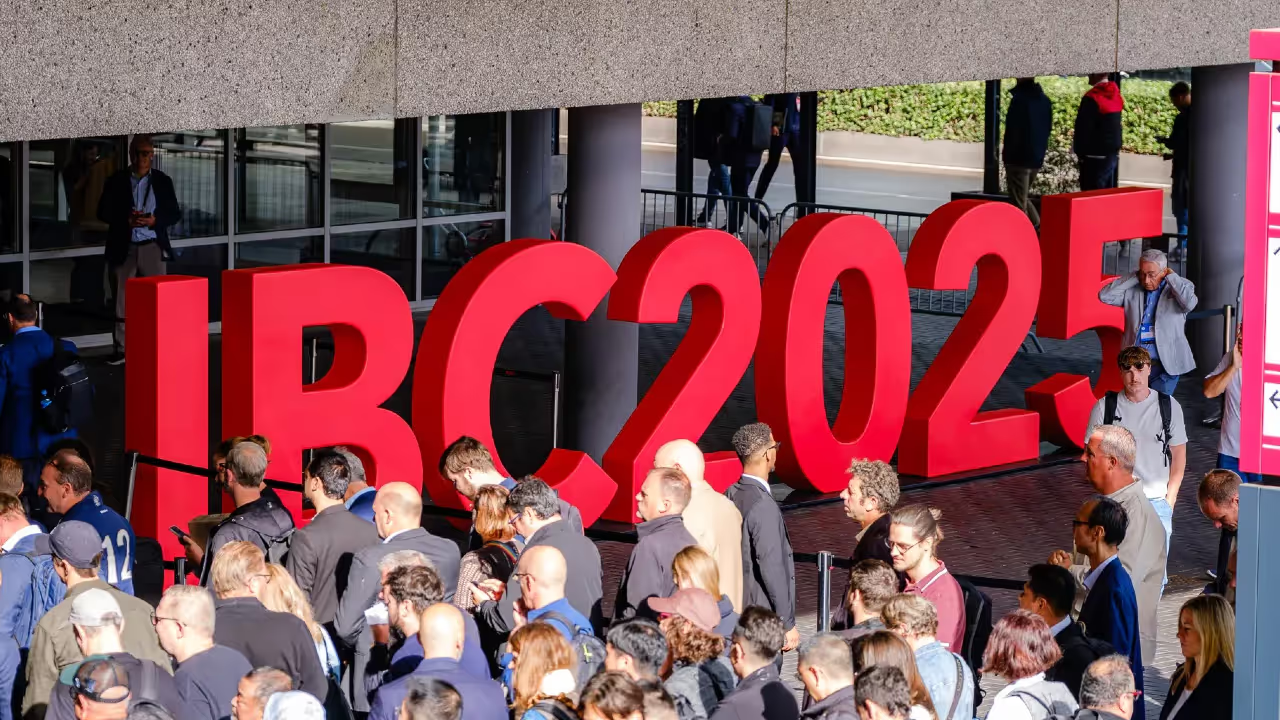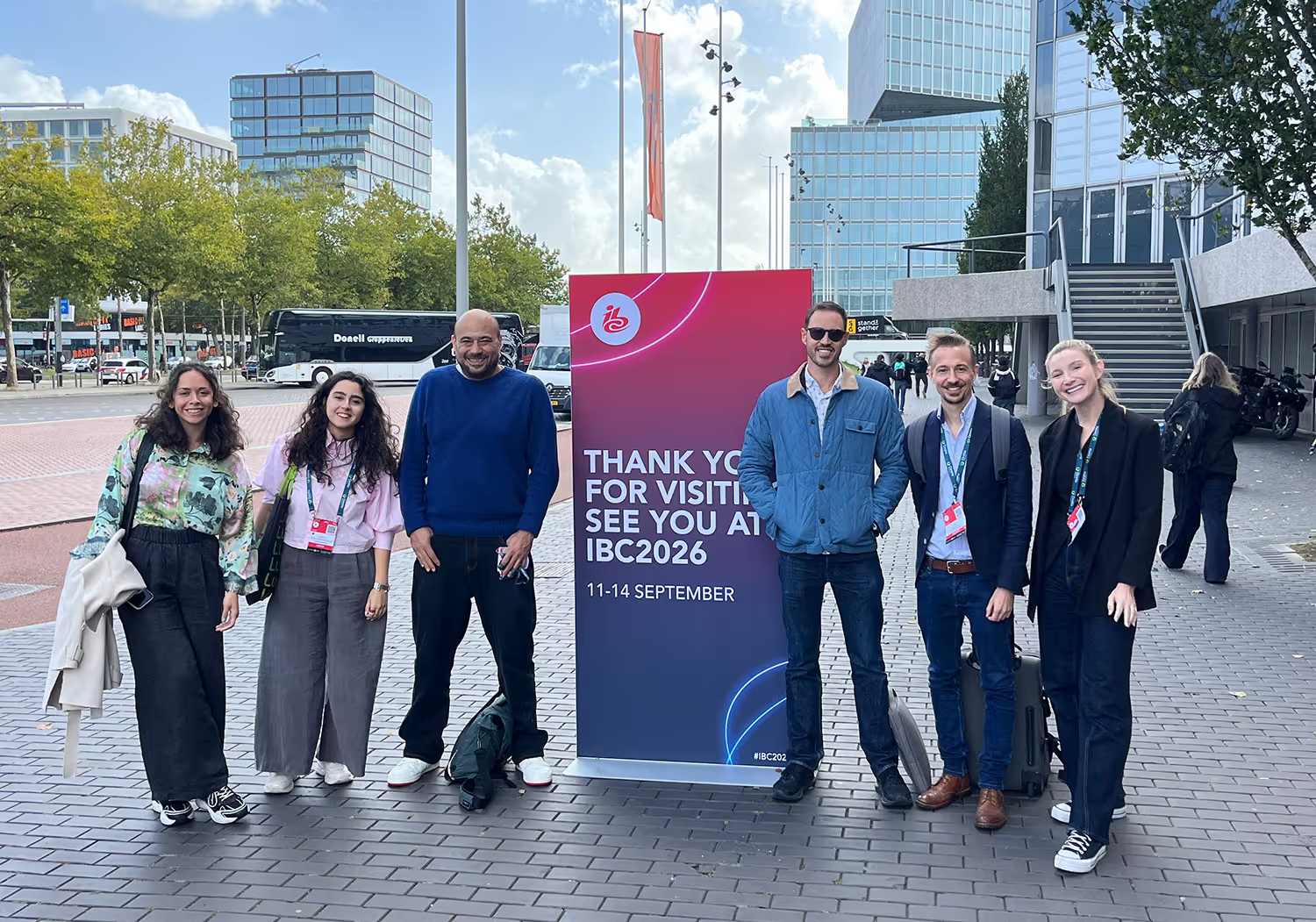IBC 2025 – an industry reinventing itself, slowly

At IBC 2025, the Caretta Research team held more than 200 meetings with broadcast and media technology vendors and buyers, and hosted a private roundtable event with 20+ global media industry industry CTOs and technology leaders. Here’s a summary of the main industry challenges and opportunities that dominated those conversations.
An optimistic industry
IBC’s published attendance numbers were down slightly (by 2.7%) but the show felt busy from Friday though to Sunday lunchtime. Most vendors we met reported good booth traffic – in terms of numbers, and quality.
Overall the mood was optimistic, contrasting with the doom and gloom atmosphere of NAB which took place in the middle of Trump’s trade tariff tinkering. As we did post-NAB, we’d urge event organisers to move away from reporting “a big number” to reporting the quality of visitors – as measured by buying power and seniority.
The great refocus: it’s all live
(…and the beginning of the end of hardware)
In my fireside chat on stage with ITN’s CTO, Jon Roberts, he noted that while streaming platform investment has been a focus, broadcasters now realise that to compete, “it’s about focusing on what’s unique, and what’s unique in a lot of broadcast situations is live content.”
We heard this same sentiment multiple times: years of intense investment in direct-to-consumer streaming platforms is largely complete (or, at least “good enough” for now), leading to a strategic pivot back towards live production as broadcasters recognise their USP in a crowded media market.
This comes at exactly the same time that the transition from SDI to IP networking has matured to the point that it’s no longer just for the largest and richest organisations – it’s become simpler, cheaper and viable for the entire market.
And it’s driven by a strong desire for more efficient operations, and exploiting the flexibility and agility in live production that IP infrastructure can unlock when accompanied by transition from dedicated hardware to software-defined solutions running on commercial-off-the-shelf (COTS) hardware.
There are still gaps. Initiatives like MXL will take time to bed in – in the meantime, broadcasters are increasingly focused on orchestration tools, despite every vendor claiming they are “the one” to do this and control the others. Some buyers disagree and some are building their own layer on top in response.
If there’s one clear warning message to many established vendors in our industry, it’s the number of times (dozens) that VMix was mentioned. It would be a mistake to dismiss it as a “prosumer” tool – it’s popping up in specific use cases everywhere. Vendors need a plan to compete, integrate or implement products like VMix that are moving into broadcast from the pro AV sector.
Software, not cloud, is the critical transformation
After years of cloud focus at IBC, the conversation has clearly pivoted – it’s now clear that the true transformation is all about software – wherever and however that’s deployed.
The trend is decisively towards hybrid, not cloud-only, solutions. Many broadcasters are running software-defined workflows on-premise, in their own data centres, or in a hybrid combination with the hyperscalers.
On-premise remains critical for top-tier live production, offering predictability, control over costs, and performance without the perceived latency and costs associated with public cloud.
Cost consciousness – all about TCO
There’s a noticeable tension between vendors’ desire to move towards recurring revenue OPEX models and buyers’ need for predictable budgets. While flexible, pay-as-you-go licensing is attractive, many buyers—particularly those with fixed budgets—still opt for CAPEX models for a whole range of very valid accounting and budgetary reasons.
A middle ground is emerging with consumption-based models where customers can purchase credits in advance, giving them flexibility combined with cost certainty.
Nevertheless, total cost of ownership (TCO) remains the critical decision-making factor for buyers, encompassing not just the initial purchase price but also ongoing SaaS and support, plus operational costs like power, cooling, and maintenance.

Gen AI becoming mainstream
After a period of being a “bullshit bingo” term, we’re seeing clear evidence of how AI is now being implemented for tangible use cases that deliver real value as the focus shifts from hype to specific, value-driven use cases.
While using AI for workflow automation (hence reducing costs) remains the #1 use case, it was the coming of age of generative AI that stood out at IBC.
We heard how one major sports network is using gen AI to create a constantly-updated highlights package during a game, allowing viewers joining the live broadcast part-way through to catch up instantly on what they’ve missed. And another factual broadcaster is using gen AI video for historical reconstructions as part of a true-crime documentary series.
It’s in advertising where gen AI is really making its presence felt, with Andy Hood, VP for Emerging Technologies at WPP, joining my IBC panel session to explain the ad giant’s focus on using gen AI to produce creative.
The consistent feedback on using gen AI for producing video content is:
- Learning how to prompt gen AI tools is a crucial new industry skill.
- Navigating the multitude of gen AI tools, which are constantly evolving, is a particular challenge. One broadcaster said it’s using 40 different tools, each of which makes regular changes to the way its prompts work.
There was mixed feedback on the role of agentic AI. As one CTO told us, “I don’t want to see another vendor adding a chatbot to their application.” Yet we saw compelling examples (and buyer interest in) emerging agentic applications, providing that layer on top of other systems that appeal to a new generation of users who expect ChatGPT to provide all.
The maturing of streaming
If the investment goldrush on streaming platforms is slowing, that doesn’t mean all of the problems are solved. The focus now is on making them efficient to run and ramping up the potential to make money.
Our CTO roundtable participants were divided on the idea of partnering with the big global streamers (à la TF1+Netflix). YouTube was a particular focus, with some finding it a crucial channel to reach audiences that don’t consume “traditional” content, and others feeling that their owned and operated streaming platforms have as much reach in their own particular markets.
Meanwhile, vertical short-form video is becoming increasingly important, often aided by AI tools to create suitable clips.
And a new buzzword for this year’s IBC, microdramas, and the potential to produce continuing episodic content in short-format. Anyone remember Quibi?
The biggest competitor for vendors remains build-it-yourself
The great build vs. buy debate continues, with some buyers leaning more towards “build” to own their core roadmap and avoid vendor lock-in, while others prefer to “buy” and integrate best-of-breed products.
However, “build” often means integrating smaller, specialised microservices via APIs, not creating a monolithic system from scratch. The quality of a vendor’s APIs and their willingness to collaborate are now as important as the core product functionality.
The recipe for success: openness, agility and intelligent assistance
Summarising the key industry trends that were crystallised at IBC, we’d urge media technology vendors and buyers to focus on:
- Openness – in the connected IP and software-defined world so crucial to support efficient live production, it’s all about vendors working together with interoperable microservices, and shifting decisively away from monolithic solutions and single-function hardware.
- Agility – flexible software, supported by flexible licensing terms, is essential to be competitive, with lower-tier solutions like VMix also finding a core role in the heart of production.
- Control – Media tech buyers are seeking greater control over their own roadmaps, budgets, and pace of transformation; and they’re finding a gap when it comes to controlling and orchestrating their new software-defined workflows.
- TCO – buyers want their suppliers to offer flexible commercial models—balancing buyers’ demand for cost certainty via CAPEX or pre-paid credits with many vendors’ preference for recurring revenues and subscriptions
- From AI Hype to Intelligent Assistance – AI has matured from a buzzword, with the focus shifting from simple automation to intelligent assistance, AI acting as a “digital media crew” capable of understanding natural language to perform complex, multi-step tasks.
If you’re interested in more insights into the industry, feel free to contact us at info@carettaresearch.com.


